-
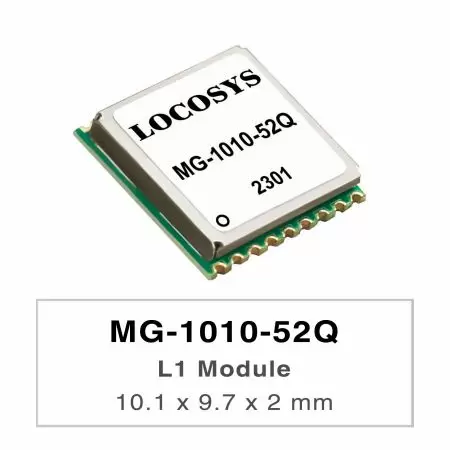
MG-1010-52Q
MG-1010-52Q
LOCOSYS MG-1010-52Q is high-performance GNSS positioning module that is capable of tracking all global civil navigation systems. It supports new GPS L1C and BEIDOU B1C signals. Based on the Airoha AG3352 platform, the MG-1010-52Q can concurrently receive and process signals from all constellations (GPS, GLONASS, BeiDou, Galileo and QZSS), which in combination with the support of SBAS greatly increases the number of visible satellites and enhances positioning accuracy. MG-1010-52Q module is based on the state of ARM® Cortex®-M4 with Floating Unit and Memory Protection Unit to integrate single band and multi-system GNSS RF band. This newly designed architecture makes this single chip achieve 1.5m CEP (open-sky) positioning accuracy representing a 40% improvement over previous generations of devices. The superior cold-start sensitivity allows it to acquire, track, and get position fix autonomously in difficult weak signal environment. Its superior tracking sensitivity allows continuous position coverage in nearly all outdoor application environments.
-
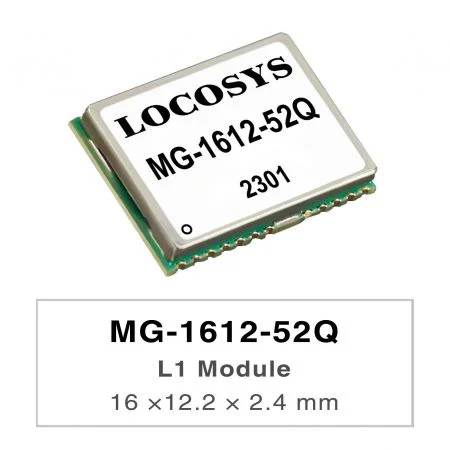
MG-1612-52Q
MG-1612-52Q
LOCOSYS MG-1612-52Q is high-performance GNSS positioning module that is capable of tracking all global civil navigation systems. It supports new GPS L1C and BEIDOU B1C signals. Based on the Airoha AG3352 platform, the MG-1612-52Q can concurrently receive and process signals from all constellations (GPS, GLONASS, BeiDou, Galileo and QZSS), which in combination with the support of SBAS greatly increases the number of visible satellites and enhances positioning accuracy. MG-1612-52Q module is based on the state of ARM® Cortex®-M4 with Floating Unit and Memory Protection Unit to integrate single-band and multi-system GNSS RF band. This newly designed architecture makes this single chip achieve 1.5m CEP (open-sky) positioning accuracy representing a 40% improvement over previous generations of devices. The superior cold-start sensitivity allows it to acquire, track, and get position fix autonomously in difficult weak signal environment. Its superior tracking sensitivity allows continuous position coverage in nearly all outdoor application environments.
-
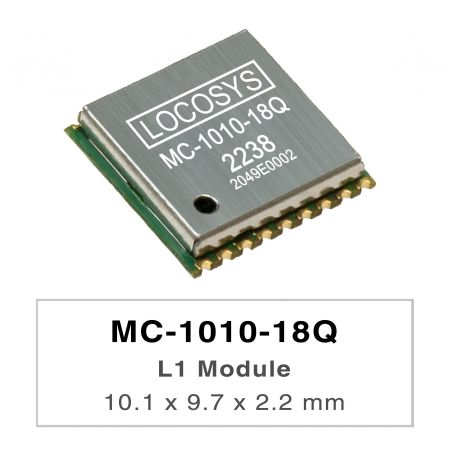
MC-1010-18Q
MC-1010-18Q
LOCOSYS MC-1010-18Q is high-performance GNSS positioning module that is capable of tracking all global civil navigation systems. It supports new GPS L1C and BEIDOU B1C signals. Based on the Airoha AG3352 platform, the MC-1010-18Q can concurrently receive and process signals from all constellations (GPS, GLONASS, BeiDou, Galileo and QZSS), which in combination with the support of SBAS greatly increases the number of visible satellites and enhances positioning accuracy. The module can achieve 1.5m CEP (open-sky) positioning accuracy representing a 40% improvement over previous generations of devices. The superior cold-start sensitivity allows it to acquire, track, and get position fix autonomously in difficult weak signal environment. Its superior tracking sensitivity allows continuous position coverage in nearly all outdoor application environments. The module supports hybrid ephemeris prediction to achieve faster cold start. One is self-generated ephemeris prediction (called EASY) that is no need of both network assistance and host CPU’s intervention. This is valid for up to 3 days and updates automatically from time to time when GNSS module is powered on and satellites are available. The other is server-generated ephemeris prediction (called EPO) that gets from an internet server. This is valid for up to 14 days. Both ephemeris predictions are stored in the on-board flash memory and perform a cold start time less than 15 seconds. The faster GNSS fixes make it possible to use accurate positioning and navigation services anytime and anywhere with a smaller power budget than previously possible. Available in a cost-optimized version as well as a low-power version which supports for the Adaptive Low Power (ALP) feature in fitness and normal navigation modes.
-
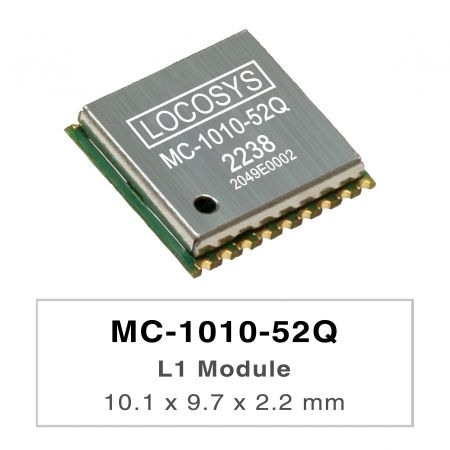
MC-1010-52Q
MC-1010-52Q
LOCOSYS MC-1010-52Q is high-performance GNSS positioning module that is capable of tracking all global civil navigation systems. It supports new GPS L1C and BEIDOU B1C signals. Based on the Airoha AG3352 platform, the MC-1010-52Q can concurrently receive and process signals from all constellations (GPS, GLONASS, BeiDou, Galileo and QZSS), which in combination with the support of SBAS greatly increases the number of visible satellites and enhances positioning accuracy. The module can achieve 1.5m CEP (open-sky) positioning accuracy representing a 40% improvement over previous generations of devices. The superior cold-start sensitivity allows it to acquire, track, and get position fix autonomously in difficult weak signal environment. Its superior tracking sensitivity allows continuous position coverage in nearly all outdoor application environments. The module supports hybrid ephemeris prediction to achieve faster cold start. One is self-generated ephemeris prediction (called EASY) that is no need of both network assistance and host CPU’s intervention. This is valid for up to 3 days and updates automatically from time to time when GNSS module is powered on and satellites are available. The other is server-generated ephemeris prediction (called EPO) that gets from an internet server. This is valid for up to 14 days. Both ephemeris predictions are stored in the on-board flash memory and perform a cold start time less than 15 seconds. The faster GNSS fixes make it possible to use accurate positioning and navigation services anytime and anywhere with a smaller power budget than previously possible. Available in a cost-optimized version as well as a low-power version which supports for the Adaptive Low Power (ALP) feature in fitness and normal navigation modes.
-
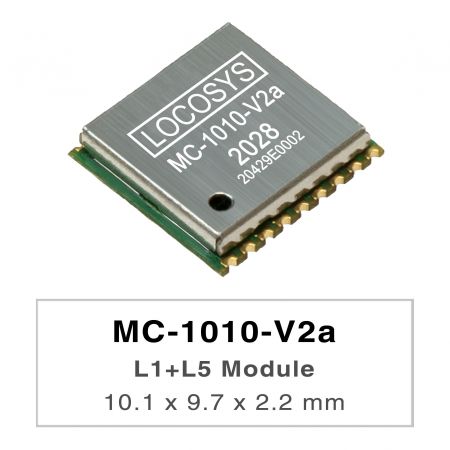
MC-1010-V2a
MC-1010-V2a
LOCOSYS MC-1010-Vxx series are high-performance dual-band GNSS positioning modules that are capable of tracking all global civil navigation systems. They adopt 12 nm process and integrate efficient power management architecture to perform low power and high sensitivity. Besides, concurrent reception of L1 and L5 band signals mitigates the multipath delay and achieves sub-meter position accuracy. The modules support hybrid ephemeris prediction to achieve faster cold start. One is self-generated ephemeris prediction (called EPOC) that is no need of both network assistance and host CPU’s intervention. This is valid for up to 3 days and updates automatically from time to time when GNSS module is powered on and satellites are available. The other is server-generated ephemeris prediction (called EPO) that gets from an internet server. This is valid for up to 14 days. Both ephemeris predictions are stored in the on-board flash memory and perform a cold start time less than 15 seconds. MC-1010-V3x with the active antenna can comply with the sensitivity specification contained in AIS 140 standard. It is the best solution to those customers that design tracking applications in compliance with AIS 140.
-
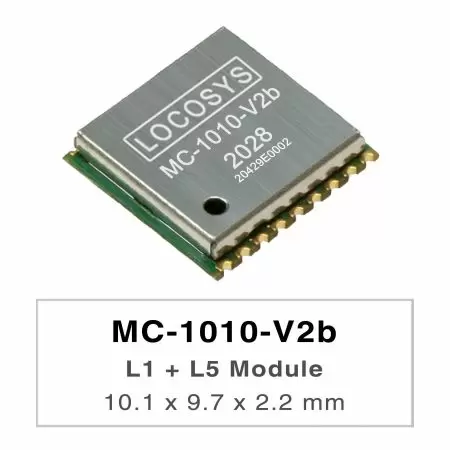
MC-1010-V2b
MC-1010-V2b
LOCOSYS MC-1010-Vxx series are high-performance dual-band GNSS positioning modules that are capable of tracking all global civil navigation systems. They adopt 12 nm process and integrate efficient power management architecture to perform low power and high sensitivity. Besides, concurrent reception of L1 and L5 band signals mitigates the multipath delay and achieves sub-meter position accuracy. The modules support hybrid ephemeris prediction to achieve faster cold start. One is self-generated ephemeris prediction (called EPOC) that is no need of both network assistance and host CPU’s intervention. This is valid for up to 3 days and updates automatically from time to time when GNSS module is powered on and satellites are available. The other is server-generated ephemeris prediction (called EPO) that gets from an internet server. This is valid for up to 14 days. Both ephemeris predictions are stored in the on-board flash memory and perform a cold start time less than 15 seconds. MC-1010-V3x with the active antenna can comply with the sensitivity specification contained in AIS 140 standard. It is the best solution to those customers that design tracking applications in compliance with AIS 140.
-

MC-1612a-V2b
MC-1612a-V2b
LOCOSYS MC-1612a-Vxx is a high-performance dual-band GNSS positioning module that is capable of tracking all global civil navigation systems. It adopts 12 nm process and integrates efficient power management architecture to perform low power and high sensitivity. Besides, concurrent reception of L1 and L5 band signals mitigates the multipath delay and achieves more accurate position. The module supports hybrid ephemeris prediction to achieve faster cold start. One is self-generated ephemeris prediction (called EPOC) that is no need of both network assistance and host CPU’s intervention. This is valid for up to 3 days and updates automatically from time to time when GNSS module is powered on and satellites are available. The other is server-generated ephemeris prediction (called EPO) that gets from an internet server. This is valid for up to 14 days. Both ephemeris predictions are stored in the on-board flash memory and perform a faster cold start. The RF front end of MC-161a-V3b the module is specifically designed to comply with sensitivity specification contained in AIS 140 standard. It is the best solution to those customers that design tracking applications in compliance with AIS 140.
-
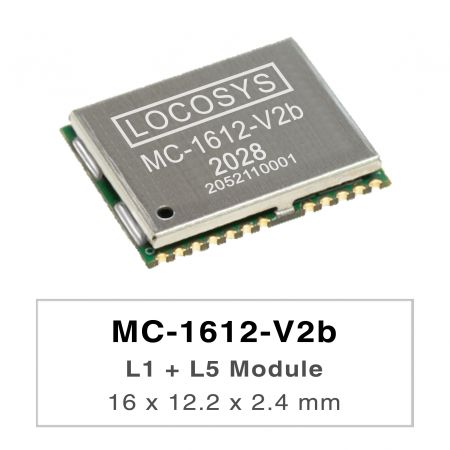
MC-1612-V2b
MC-1612-V2b
LOCOSYS MC-1612-Vxx series are high-performance dual-band GNSS positioning modules that are capable of tracking all global civil navigation systems. They adopt 12 nm process and integrate efficient power management architecture to perform low power and high sensitivity. Besides, concurrent reception of L1 and L5 band signals mitigates the multipath delay and achieves sub-meter position accuracy. The modules support hybrid ephemeris prediction to achieve faster cold start. One is self-generated ephemeris prediction (called EPOC) that is no need of both network assistance and host CPU’s intervention. This is valid for up to 3 days and updates automatically from time to time when GNSS module is powered on and satellites are available. The other is server-generated ephemeris prediction (called EPO) that gets from an internet server. This is valid for up to 14 days. Both ephemeris predictions are stored in the on-board flash memory and perform a cold start time less than 15 seconds The RF front end of MC-1612-V3b the module is specifically designed to comply with sensitivity specification contained in AIS 140 standard. It is the best solution to those customers that design tracking applications in compliance with AIS 140.
-
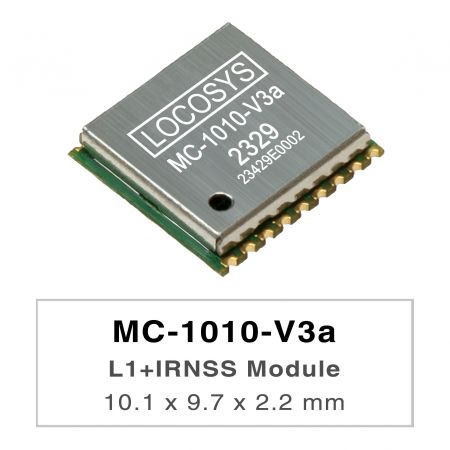
MC-1010-V3a
MC-1010-V3a
LOCOSYS MC-1010-Vxx series are high-performance dual-band GNSS positioning modules that are capable of tracking all global civil navigation systems. They adopt 12 nm process and integrate efficient power management architecture to perform low power and high sensitivity. Besides, concurrent reception of L1 and L5 band signals mitigates the multipath delay and achieves sub-meter position accuracy. The modules support hybrid ephemeris prediction to achieve faster cold start. One is self-generated ephemeris prediction (called EPOC) that is no need of both network assistance and host CPU’s intervention. This is valid for up to 3 days and updates automatically from time to time when GNSS module is powered on and satellites are available. The other is server-generated ephemeris prediction (called EPO) that gets from an internet server. This is valid for up to 14 days. Both ephemeris predictions are stored in the on-board flash memory and perform a cold start time less than 15 seconds. MC-1010-V3x with the active antenna can comply with the sensitivity specification contained in AIS 140 standard. It is the best solution to those customers that design tracking applications in compliance with AIS 140.
-
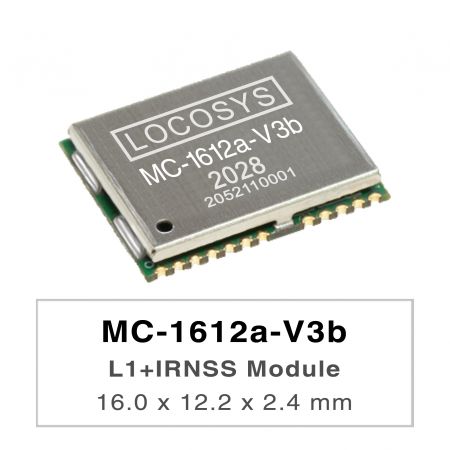
MC-1612a-V3b
MC-1612a-V3b
LOCOSYS MC-1612a-Vxx is a high-performance dual-band GNSS positioning module that is capable of tracking all global civil navigation systems. It adopts 12 nm process and integrates efficient power management architecture to perform low power and high sensitivity. Besides, concurrent reception of L1 and L5 band signals mitigates the multipath delay and achieves more accurate position. The module supports hybrid ephemeris prediction to achieve faster cold start. One is self-generated ephemeris prediction (called EPOC) that is no need of both network assistance and host CPU’s intervention. This is valid for up to 3 days and updates automatically from time to time when GNSS module is powered on and satellites are available. The other is server-generated ephemeris prediction (called EPO) that gets from an internet server. This is valid for up to 14 days. Both ephemeris predictions are stored in the on-board flash memory and perform a faster cold start. The RF front end of MC-161a-V3b the module is specifically designed to comply with sensitivity specification contained in AIS 140 standard. It is the best solution to those customers that design tracking applications in compliance with AIS 140.
-
-52Q-1.jpg?v=d98f8a7b)
LC20032(M)-52Q
LC20032(M)-52Q
LC20032(M)-52Q is based on the proven technology found in LOCOSYS 47 channel GNSS SMD type receiver MG-1612-52Q that uses Airoha chip solution, designed for a broad spectrum of OEM system applications. This module providing fast time-to-first-fix, one-second navigation update and low power consumption. It can provide you with superior sensitivity and performance even in urban canyon and dense foliage environment. Its far-reaching capability meets the sensitivity requirements of car navigation as well as other location-based applications. This module supports hybrid ephemeris prediction to achieve faster cold start. One is self-generated ephemeris prediction that is no need of both network assistance and host CPU’s intervention. This is valid for up to 3 days and updates automatically from time to time when GNSS module is powered on and satellites are available. The other is server-generated ephemeris prediction that gets from an internet server. This is valid for up to 14 days. Both ephemeris predictions are stored in the on-board flash memory and perform a faster cold start time.
-

MGS-1818-52Q
MGS-1818-52Q
MGS-1818-52Q is a complete standalone multi-frequency GNSS smart antenna module, including embedded patch antenna and GNSS receiver circuits which is based Airoha AG3352Q platform. The module can simultaneously acquire and track multiple satellite constellations that include GPS, GLONASS, GALILEO, BAIDOU, and QZSS simultaneously, which in combination with the support of SBAS, greatly increases the number of visible satellites and enhances positioning accuracy. Its superior cold-start sensitivity allows it to acquire, track, and get position fix autonomously in difficult weak signal environment. Its superior tracking sensitivity allows continuous position coverage in nearly all outdoor application environments. The module supports hybrid ephemeris prediction to achieve faster cold start. One is self-generated ephemeris prediction (called EASY) that is no need of both network assistance and host CPU’s intervention. This is valid for up to 3 days and updates automatically from time to time when GNSS module is powered on and satellites are available. The other is server-generated ephemeris prediction (called EPO) that gets from an internet server. This is valid for up to 14 days. Both ephemeris predictions are stored in the on-board flash memory and perform a cold start time less than 15 seconds. The faster GNSS fixes make it possible to use accurate positioning and navigation services anytime and anywhere with a smaller power budget than previously possible. Available in a cost-optimized version as well as a low-power version which supports for the Adaptive Low Power (ALP) feature in fitness and normal navigation modes.
-
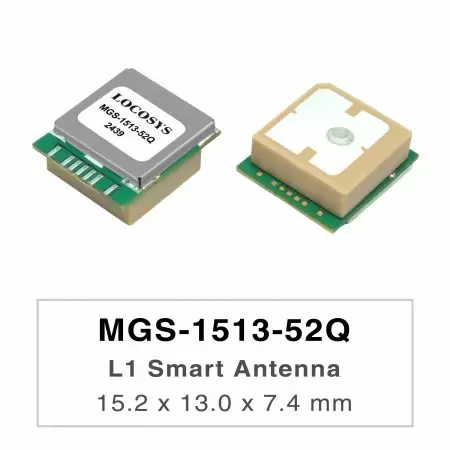
MGS-1513-52Q
MGS-1513-52Q
MGS-1513-52Q is a complete standalone multi-frequency GNSS smart antenna module, including embedded patch antenna and GNSS receiver circuits which is based Airoha AG3352Q platform. The module can simultaneously acquire and track multiple satellite constellations that include GPS, GLONASS, GALILEO, BAIDOU, and QZSS simultaneously, which in combination with the support of SBAS, greatly increases the number of visible satellites and enhances positioning accuracy. Its superior cold-start sensitivity allows it to acquire, track, and get position fix autonomously in difficult weak signal environment. Its superior tracking sensitivity allows continuous position coverage in nearly all outdoor application environments. The module supports hybrid ephemeris prediction to achieve faster cold start. One is self-generated ephemeris prediction (called EASY) tha is no need of both network assistance and host CPU’s intervention. This is valid for up to 3 days and updates automatically from time to time when GNSS module is powered on and satellites are available. The other is server-generated ephemeris prediction (called EPO) that gets from an internet server. This is valid for up to 14 days. Both ephemeris predictions are stored in the on-board flash memory and perform a cold start time less than 15 seconds. The faster GNSS fixes make it possible to use accurate positioning and navigation services anytime and anywhere with a smaller power budget than previously possible. Available in a cost-optimized version as well as a low-power version which supports for the Adaptive Low Power (ALP) feature in fitness and normal navigation modes.
-
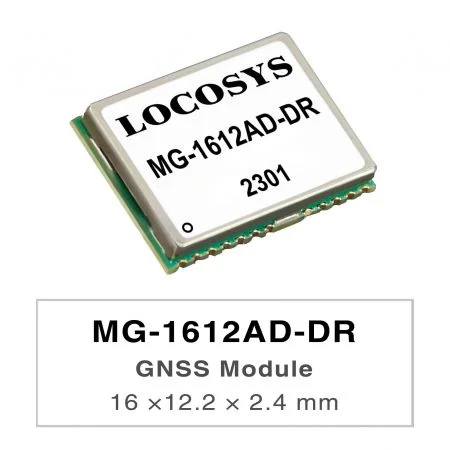
MG-1612AD-DR
MG-1612AD-DR
LOCOSYS MG-1612AD-DR is using an Airoha AG3335AD chip, dual-frequency multi-constellation solution GNSS with sensor fusion dead reckoning module. It not only supports GPS, GLONASS, GALILEO, BEIDOU and QZSS, but also has inertial sensors (3 axis accelerometers and 3-axis gyros) to provide untethered dead reckoning function. In addition to DR, an inertial sensor can detect the vehicular dynamics when it is attached firmly on the vehicle. Consequently, abnormal driving behaviors and the vehicle status can be detected and the alarm status will be enabled to remind the users. No requirement of installation orientation and automatic calibration function make it easy to use. With these features, MG-1612AD-DR can reduce position errors in multipath environment and continue to work where GNSS signals are poor or not available, such as tunnels and indoor parking lots, as well as deliver seamless navigation.
-

RTK-1612AD-DR
RTK-1612AD-DR
LOCOSYS RTK-1612AD-DR uses an Airoha AG3335AD chip, dual-frequency multi-constellation solution GNSS, providing RTK high precision and sensor fusion solution in one. It not only supports GPS, GLONASS, GALILEO, BEIDOU, and QZSS but also has inertial sensors (3-axis accelerometers and 3-axis gyros) to provide an untethered dead reckoning function. In addition to DR, an inertial sensor can detect the vehicular dynamics when it is attached firmly on the vehicle. Consequently, abnormal driving behaviors and the vehicle status can be detected and the alarm status will be enabled to remind the users. No requirement of installation orientation and automatic calibration function make it easy to use. With these features, RTK-1612AD-DR can reduce position errors in multipath environment and continue to work where GNSS signals are poor or not available, such as tunnels and indoor parking lots, as well as deliver seamless navigation.
-
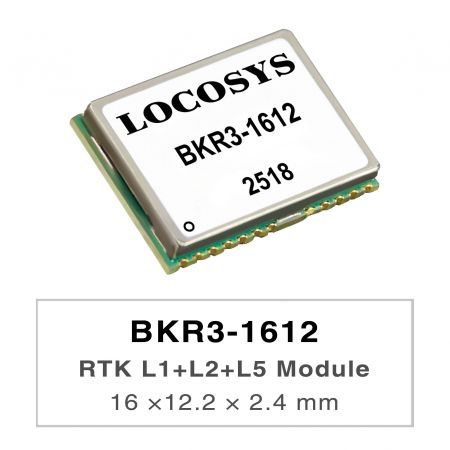
BKR3-1612
BKR3-1612
The BKR3-1612 GNSS module, developed by LOCOSYS Technology Inc., is engineered for applications requiring high-precision positioning and exceptional reliability. Built upon an advanced GNSS SoC architecture and incorporating the latest BDS-3 (BeiDou Navigation Satellite System) framework, the module supports multi-band and multi-constellation reception capabilities. It can concurrently track all major global satellite navigation systems, including GPS, GLONASS, Galileo, BEIDOU, QZSS, IRNSS, and SBAS, while offering full support for L1, L2, and L5 triple-band signal reception with centimeter-level RTK positioning accuracy. At the core of the module is the Beken chip, featuring a 32-bit DSP processor built on 22nm process technology and capable of operating at up to 350MHz. The chip supports up to 200 tracking channels and integrates a dedicated high-performance search engine. It delivers excellent sensitivity across cold start, hot start, and reacquisition modes (from -148dBm to -165dBm), ensuring stable and reliable positioning performance even in challenging signal environments such as dense urban areas or under canopy. The Beken also supports AGPS, RTCM3.X, and offers a maximum update rate of 20Hz, enhancing system responsiveness in dynamic applications.
-
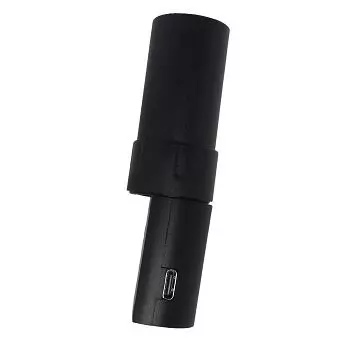
RTK for Android system
RTK for Android system
LOCOSYS unveiled RTK Dongle (Product name is RTK-4P) which is able to receive L1 / L2 frequency and equipped with a multi-frequency Helix antenna, The positioning accuracy specification is "cm level" which is directly connected to the Smart Phone's USB Type-C and allow the smart phone to be immediately upgraded and aimed to high-precision (RTK) applications which can be used for geographic mapping、earth-rock surveying、agricultural surveying、cadastral surveying and other purposes.
-

LS-125-A/LS-125F-A
LS-125-A/LS-125F-A
LS-125-A is a four-star multi-frequency satellite navigation antenna. The antenna has the characteristics of high gain, miniaturization, high sensitivity, multi-system compatibility and high reliability, which can effectively meet the needs of users. LS-125F-A is a high-precision air-type multi-band measurement antenna that supports the reception of satellite navigation signals from multiple systems such as BDS, GPS, GLONASS, and Galileo. The antenna uses air medium technology and features high gain, good circular polarization performance, high positioning accuracy, and good reception performance at low elevation angles. It can be used in areas such as driver training, unmanned driving base station reference station networking requirements, and high-precision mapping.
-
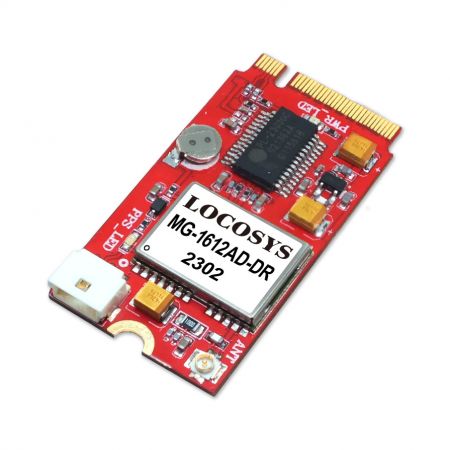
M.2-35AD
M.2-35AD
LOCOSYS M.2-35AD is a L1+L5 high-performance dual-band GNSS RTK module based on the very small industry standard M.2 Type B form factor. Using the USB bus, provides global positioning information, while taking up little space and power within a system. Supporting for Windows and Linux, the M.2-35R can easily integrate into any existing system, as well as easily implemented into new systems. LOCOSYS M.2-35AD builds in LOCOSYS High Precision MC-1612AD-DR module which is using an Airoha AG3335AD chip, dual-frequency multi-constellation solution GNSS with sensor fusion dead reckoning module. It not only supports GPS, GLONASS, GALILEO, BEIDOU and QZSS, but also has inertial sensors (3-axis accelerometers and 3-axis gyros) to provide untethered dead reckoning function. In addition to DR, an inertial sensor can detect the vehicular dynamics when it is attached firmly on the vehicle. Consequently, abnormal driving behaviors and the vehicle status can be detected and the alarm status will be enabled to remind the users. No requirement of installation orientation and automatic calibration function make it easy to use.
-

M.2-R35AD
M.2-R35AD
LOCOSYS M.2-R35AD is a L1+L5 high-performance dual-band GNSS RTK module based on the very small industry standard M.2 Type B form factor. Using the USB bus, provides global positioning information, while taking up little space and power within a system. Supporting for Windows and Linux, the M.2-R35AD can easily integrate into any existing system, as well as easily implemented into new systems. LOCOSYS M.2-R35AD builds in LOCOSYS High Precision RTK-1612AD-DR module which is using an Airoha AG3335AD chip, dual-frequency multi-constellation solution GNSS with sensor fusion dead reckoning module. It not only supports GPS, GLONASS, GALILEO, BEIDOU and QZSS, but also has inertial sensors (3-axis accelerometers and 3-axis gyros) to provide untethered dead reckoning function. In addition to DR, an inertial sensor can detect the vehicular dynamics when it is attached firmly on the vehicle. Consequently, abnormal driving behaviors and the vehicle status can be detected and the alarm status will be enabled to remind the users. No requirement of installation orientation and automatic calibration function make it easy to use.
Press Release
-
 Taiwan Excellence Drone Alliance Visits LOCOSYS Technology, Focusing On Global Positioning Technology And Drone Applications
Taiwan Excellence Drone Alliance Visits LOCOSYS Technology, Focusing On Global Positioning Technology And Drone ApplicationsThe Taiwan Excellence Drone Overseas Business Alliance, led by Yen Tung-Piao,visited a leading smart manufacturing enterprise with a delegation includingrepresentatives from AIDC, the Industrial...
Read More -
 LOCOSYS Showcases Advanced Smart Positioning Technology At New Taipei Electric Vehicle Supply Chain Expo
LOCOSYS Showcases Advanced Smart Positioning Technology At New Taipei Electric Vehicle Supply Chain ExpoTo promote the development of Taiwan's electric vehicle (EV) industry and enhance international collaboration, the New Taipei City Government hosted the Electric Vehicle Supply Chain Expo...
Read More -
 LOCOSYS Technology Unveils New High-Performance SONY GNSS/RTK Global Satellite Positioning Modules
LOCOSYS Technology Unveils New High-Performance SONY GNSS/RTK Global Satellite Positioning ModulesLOCOSYS will showcase its advanced RTK solutions and high-performance GNSS modules, including those powered by Sony’s latest GPS technology, at the 2024 Sensor Expo in Tokyo. These modules,...
Read More
